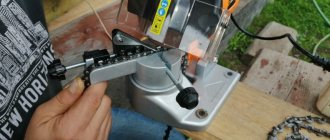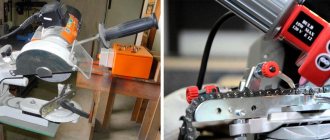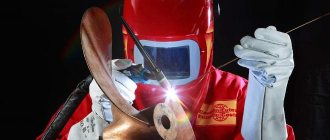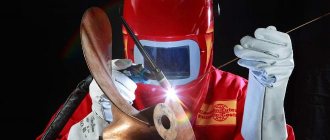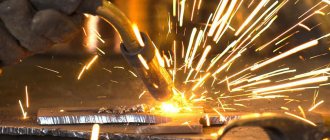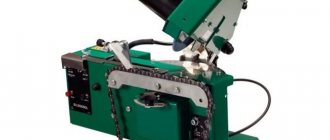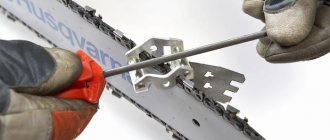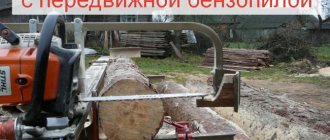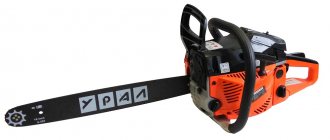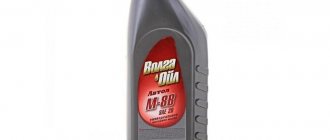When should the work be done?
When using a chainsaw intensively, sharpening is carried out quite often, often several times in one day. Particular attention should be paid to the fact that the contact of the chain with the ground significantly speeds up the process. Therefore, chainsaws must be used in such a way as to eliminate the possibility of contact between the chain and the ground. After several contacts, the chips will be very small, and the chain will go deeper into the material slightly. When considering this issue, it can be noted: the more often you have to sharpen the chainsaw chain, the less metal layer is removed. Also, if you sharpen frequently, the service life of the cutting element of the chainsaw will increase significantly. The main condition can be called the correct execution of the work, if you do it yourself. The procedure can only be performed correctly if you have a special machine. A sign that the cutting element of a hand chainsaw has become dull is a significant feed force. Properly sharpened chains determine a significant reduction in the feed force, that is, the chainsaws enter easily with a little pressure. Another sign of the need to sharpen chains is the production of very small chips. Sharpening a chainsaw when the signs in question appear is mandatory. Sharpening of chains is carried out in order to greatly reduce the tension in the body, reduce the cyclic load rate and fuel consumption. Also, if you do not sharpen the teeth of the chains on time, there is a possibility of increased wear of all components, as a result of which the service life of the hand chainsaw is reduced.
Geometry Features
In order to sharpen correctly with your own hands, even if you use a machine, you should know the geometry of the tooth. Its constituent elements include:
- Spatula.
- The main link.
- Depth limiter.
In this case, the tooth blade consists of the following elements:
- End blade.
- Top blade.
You need to sharpen correctly with your own hands, taking into account the fact that the end and top blades must be positioned correctly relative to each other to ensure the best cutting performance. The back of the tooth forms a certain angle of the upper blade. A similar angle is formed to cut the blades into the material. Sharpening with your own hands should also take into account the fact that the blade has a narrowing towards the back - this design feature forms the angle of the end blade. It is created to ensure lateral cutting of chips.
Chainsaw chain tooth
The sliding surface and the end part of the blade forms the rake angle. In this case, the angle has a fixed value; it varies from 60 to 85 degrees. If you sharpen the teeth with your own hands, it is worth considering that the upper blade is the main one, and the angle formed by it is the most important angle. To summarize, when considering the issue of geometry features, we note that the sharpening angle can vary depending on the conditions of use. The basic rule that should be followed when sharpening a tooth with your own hands is the following: the higher the angle, the greater the performance of the chainsaw, but reducing the value ensures smoother running of the blades, reduced vibration and increased service life. It is worth sharpening taking into account that the indicator should be in the range from 25 to 35 degrees. An exception is the version of the blade, which is intended for longitudinal cutting - many manufacturers of the chainsaw cutting element can withstand 10 degrees.
Saw design
To better understand what a chainsaw is and how it works, it is advisable to know how it works.
By the way, it would be more correct to call the cutting tool of a chainsaw a saw chain.
The first saw chains appeared at the beginning of the twentieth century. The designers did not begin to puzzle; they simply mounted teeth on the chain, which quickly lost their functionality. In appearance they resembled those that stand on hand hacksaws for wood. Sharpening such a chainsaw caused great difficulties. But repeated attempts to create the perfect saw chain were crowned with success only in 1947.
Chainsaw device
This chainsaw has links with an L-shaped cut. Modern chains are, in fact, the direct ancestors of this development.
If during work the cutting speed begins to decrease, the chainsaw in the hands of the master begins to “walk”, then most likely the saw chain has lost its operational properties, that is, it has become dull and measures must be taken to restore them.
Chain structure in a chainsaw
In fact, the circuit is quite simple.
One of its main elements are the teeth, which are located on both the left and right sides, and which alternate. They are connected to each other through other links, namely connecting ones. They are made directly from specialized steel material. In addition, the upper part of the steel is coated with a hard chrome coating, which significantly increases the service life of the chainsaw. Also important parts of the chain of this type of tool are:
- cutting link;
- side and top edges;
- depth shear limiter.
Now let's try to understand the issue regarding the reasons for the blunting of the chain itself. Why does this happen and what factors influence it? This issue is quite serious, since the productivity of the chainsaw itself depends primarily on the sharpness of the teeth on the chain. So, let's take everything in order.
feel strong vibrations from the tool while working , and notice that the tool moves slowly, then be sure that the chain on your device is dull. This is mainly caused by intensive and excessive use of the tool.
In addition, contact directly with the ground or with much harder wooden elements is important.
In addition, it is worth noting that working with such a chainsaw is highly undesirable, since this kind of negligence can lead to significant problems. Among which are not only significantly high fuel consumption and very slow cutting, but also vibrations directly on the body, and this, in turn, leads to breakage of the sprocket and even the tire itself.
Why does the tool become dull?
Each chainsaw has a certain durability period. This is the time from the start of work with a new tool until it becomes inoperable.
Destruction or wear of a cutting tool intended for woodworking occurs due to the impact of a set of forces arising during the cutting process. One of the key ones is friction force. Dulling of the saw chain occurs due to prolonged work, due to the use of a chainsaw for purposes other than its intended purpose.
The amount of wear can be defined as a measure of weight, measured in milligrams. Wear is a parameter that shows a change in the characteristics of the shape and size of the cutting blade. The change in geometric parameters that occurs during cutting, and there is no linear wear, is called blunting.
There are parameters on the basis of which a decision is made about the possibility of further operation of the tool. In particular, when examining the teeth of a saw chain, it is necessary to pay attention to the edges of the front and rear surfaces, the height of the blade, and the wear area. If they are in unsatisfactory condition, it means it’s time to sharpen the chainsaw.
Signs that the saw has lost its sharpness include the following:
- Reducing chip size.
- Using more force to do the job.
How to properly put a chain on a power saw?
To install a new cutting set, the user of a garden electric saw will need a screwdriver, gloves made of thick fabric, and a wrench.
To install the chain on the electric saw, you need to follow the following procedure:
- First, you need to unscrew the guide bar mounting nuts using a wrench. Before doing this, it is important to make sure that the inertia brake is in the off position. Otherwise, the operator risks breaking the tension cable of the inertial mechanism;
- Then you need to carefully move the brake pad to the side;
- Next, you need to move the guide bar, while trying to engage the drive sprocket of the electric saw. This is necessary in order to remove the part of the tire mounted on the sprocket. The rest of the guide - its shank, is attached in special holes;
- After this, you need to put the chain on the electric saw and adjust the tension of the cutting element, using a separate plastic tensioner for this;
- Then you will need to install the protective cover and unscrew the bolts securing it completely.
https://www.youtube.com/watch?v=grQnNG8cifE
Whenever installing a cutting tool, you need to pay attention to the level of its tension and the force that needs to be applied to manually rotate it along the tire. If necessary, the screws must be loosened or tightened, otherwise the cutting element will jam or constantly fly off the guide.
When to sharpen and how to find out about it
After examining the saw chain, the master decides whether it is time to sharpen the tool or not.
As a rule, the saw chain loses its performance properties during intensive work. It can get to the point where the chain will have to be sharpened several times in one day. The cause may also be contact of the saw with the ground. In fact, just scrape the saw chain across the ground a few times and you can stop all work. The chainsaw will simply stop going into the tree. By the way, one of the signs of a dull saw is the appearance of small chips.
Dull chainsaw chain
The sooner measures are taken to sharpen the chain, the longer it will last. It is quite easy to understand when resharpening is required. There will be a feed change. A chain with properly sharpened teeth will retract even with a small force, but if during operation you have to exert a greater feeding force, then this means only one thing, the teeth have lost their sharpness.
Do not use a blunt chain. By the way, this is a safety requirement. And the process will require significant muscular effort from the lumberjack. As a result, this leads to a decrease in cut quality, an increase in the amount of fuel used and accelerated chain wear.
Signs of a dull chain and the consequences of further use
The difficulty of working with a dull chainsaw should not be confused with the difficulty of cutting hardwood or very dry logs. In all these cases, the speed of the operation is reduced, but the blunt instrument has a certain behavior - signs by which one can judge the need for sharpening:
- the chainsaw does not immediately bite into the tree trunk, as if grinding, moving away from the point of contact;
- when cutting soft rocks, the tool sluggishly penetrates the thickness of the wood, you have to put pressure on the bar;
- the shavings from large ones with characteristic oblong particles turn into small thyrsus, which very rarely crumble;
- the chain heats up quickly, an unpleasant smell of burning oil for lubricating the guide bar is heard.
In addition to these alarming signals, always after hitting metal nails, wires with a chain, or burying a chainsaw in the ground, you can be one hundred percent sure of the need for subsequent sharpening of the cutting edges.
What can happen to the instrument in the future if the problem is ignored? The most harmless thing is that it will be impossible to work with a chainsaw; in the end it will get boring and will force you to service the unit. But adherents of the saying “You don’t need intelligence to eat power” can come to the following conclusion:
- extra stress on the body, because, frankly speaking, you have to put pressure on the tool so that it cuts;
- excessive fuel consumption of up to 30%, which is explained by the need to go through a larger revolution cycle to achieve the same result;
- accelerated wear of the tire and other parts of the chainsaw.
In addition to all these negative consequences of a dull saw, there is a high probability of the chain jamming in the barrel and injury to the operator performing the work.
File
A file can be used to carry out the work in question. A file is used to remove the required layer of metal from the surface. A special set was created for this case:
- The file is round and has an unusual holder.
- Flat file needed to adjust the depth limit.
- Hook.
- Special template.
The round file holder is created along with marking lines that are used to position the tool correctly. During operation, the plate itself comes into contact with the depth stop and the surface of the blades, and the file moves around and removes a layer of metal. The use of a special holder with a file allows you to ensure the correct fit of the tools to the surface being processed. You should only use a file that is designed to perform such work.
Angles of inclination when sharpening with a file
The rules of work include:
- The same number of movements should be done.
- It is necessary to control the force of pressure on the surface during processing.
- The template, which is used together with the file, allows you to maintain important sharpening parameters.
With different lengths, uneven travel and the formation of cracks in the material are observed. If the length indicator is not the same at the start of processing, then all cutting teeth are filed according to the indicator of the smallest one.
How is a power saw chain lubricated?
To lubricate the saw blades, the design of any household electric saw provides a separate system, the basis of which is a pump. During operation, it creates the pressure necessary to pump oil from the reservoir into the grooves provided in the guide. From there, the oil enters individual grooves or holes located in the cutting teeth of the chain.
To prevent the cutting parts of the electric saw from running dry, you need to constantly monitor the volume of oil in the tank. If necessary, the operator must top up the amount of fluid used.
Pump failure causes typical problems. The most common of them is a situation in which the chain on the electric saw is not lubricated. In this case, the owner of the electric saw must immediately replace the pump, having first cleaned the place where it is installed in the garden tool.
Lubrication of the electric saw chain should only be done using specialized oil. Manufacturers of garden equipment prohibit the filling of transmission compounds and waste fluids. They quickly clog the lubrication system pump, which leads to its overheating and breakdown.
It is best to use specialized oils from Stihl, Husqvarna, Ravenol, Liqui Moly and Motul to lubricate the cutting headset of an electric saw. They are distinguished by high adhesion, biodegradability, and the ability to protect cutting organs from wear and corrosion. Oils of these brands work properly in wide temperature ranges and are not afraid of high air humidity.
Application of special machines
It is not always possible to use a hand tool with a template. For example, if the cutting edge comes into contact with the ground during operation, there is a possibility of its deformation. In this situation, a special machine is used. The machine comes in two types:
- Mechanical.
- Electric.
The power saw has a design that looks like a bow saw, but with a round file. The machine can be used to level the length of all edges and restore the correct geometry. The machine in question has a complex system for setting processing parameters. Sharpening is performed in approximately 2-3 movements, after which the machine is installed in a new location.
The electric machine is easy to use. A special adjustment system allows you to correctly position the surface to be treated, as well as position the disc with high accuracy. Some models have an automatic vice clamping system when the disk is lowered. The cost of the electric version is slightly higher, but at the same time the performance increases significantly and the most accurate result can be achieved.
PDF Guide to Sharpening Stihl Saw Chains
How to properly sharpen a chainsaw chain with your own hands. Step-by-step instruction
Bringing a chain into working condition has its own characteristics. They are determined by the configuration of the tooth. It includes two edges, located - one at the top and the other at the bottom. Moreover, the edge located towards the top has a slope at a given angle. In fact, the tooth, both in geometry and in its operating principle, is similar to the blade of a carpenter’s plane.
Manual chain sharpening diagram
For competent sharpening, the master must understand the structure of the tooth.
Teeth parameters
The tooth structure consists of:
- grounds;
- shoulder blades;
- limiter.
Two cutting edges are formed on the blade, one is placed on a horizontal plane, the other at an angle. To obtain the required parameters, the blades are sharpened at the angle specified in the technical specifications. The rake angle is sharpened in the range from 60 to 85 °.
The clearance angle indicates the backward tilt of the upper blade. It lies in the range of 50 to 60°. The blade located on top is considered the main one; the rear angle in this design is very important. It is difficult to measure; if the sharpening rules are followed and the geometric parameters are observed, it is formed in the specified range.
Teeth
The corners are sharpened depending on the use of the tool. The main rule is that the larger the angle, the greater the efficiency when processing soft wood; the smaller the angle, the easier it is to operate the saw with hard wood. That is, the smoothness of operation improves and the vibration of the tool decreases.
Meanwhile, the situation of sharpening the angle greater than 35 and less than 25° should be avoided. This rule does not apply to rip chains.
The angles change when editing the tool. They have an important impact on cutting parameters, so all technical requirements must be carefully followed.
Tips and tricks on how to sharpen a chainsaw at home
It is permissible to use a file for sharpening, but you must understand that such operation of the saw will require certain skills and, of course, patience from the master. To sharpen each tooth, you need to have flat and round needle files on hand. To sharpen a tooth, without using additional equipment, it is necessary to maintain the basic sharpening inclination. Only 2-3 passes with a file are enough for sharpening, so there is no point in inventing some kind of equipment to fix the tooth in a certain position. To sharpen the top edge, the file must be held at the required angle while working. Restoring operability begins with preparation, namely, from the working edges; it is necessary to remove all nicks.
If everything is clear with the angles of the teeth with straight parts of the structure, then the edge located on the side and its working inclination cause certain difficulties. To straighten them, you need to use a round file or a small file. These tooth elements are sharpened at the required angle.
Sharpening a chain with a grinder
The process is quite fast, but it is worth remembering precautions: one wrong move can completely ruin the chain or the entire bar.
In addition, the chainsaw must be securely fastened so as not to jump off and injure the owner.
The stages of sharpening with a grinder include:
- Securing the chain to the bar.
- Installation of a disc up to 2 mm thick on a grinder. Craftsmen recommend taking an old disk with an already marked edge.
- Installing a barrier between the bar and the chain (you can put a sliver).
- Sharpen the chain teeth on both sides at an angle of 30 degrees. There is no need to put excessive pressure on the tooth. It is important not to overheat the metal or cut off too much.
- Pull the chain.
Sharpening on a machine
If sharpening work is carried out quite often, then it is necessary to use special equipment and technological equipment (templates). Using a template on a device of this type allows you to complete this work much faster. Such a device can be a wooden block of small size. This type of template should allow sharpening at two angles. Sharpening can be done using a small diameter grinding wheel or an emery belt that can be mounted in place of the belt drive.
Chainsaw chain sharpening machine
Sharpening a chainsaw chain with a machine
Machines of this type, masters, can be made independently, using the drive from a foot-operated sewing machine as the basis for the design. Using a belt drive and a template, it is possible to process one cutting edge and then another.
How to choose the right chain for a power saw?
When purchasing a cutting tool for a household electric saw, its owner must pay attention to the following criteria:
- compatibility with garden tools - the operator must select a chain for an electric saw from the same manufacturer that produces the garden tools on the farm. In this case, the risk of making a mistake will be minimized;
- The purpose of the chain is that saw blades with a pitch of 3/8″ stand out for their relatively high productivity. They are suitable for solving the most complex tasks on site. If the electric saw is not used often, it can be equipped with chains with a pitch of 0.325″;
- chain sharpening angle - this parameter must be taken into account for further restoration of the cutting organ. The saw blades are sharpened in 3/8″ increments at an angle of 30⁰. Chains of this type can easily withstand high loads and intense heat. If an electric saw is often used to work with damp or frozen wood, then it is best to install chains with a sharpening angle of 10⁰;
- chain length - according to this parameter, the saw element must correspond to the guide of the electric saw. Otherwise, the user will not be able to install the part on the tire. To determine the length of the electric saw bar, the operator just needs to study its markings. It shows the guide size in inches or centimeters.
Another important parameter is the brand manufacturer of the element. It is best to trust cutting tools from trusted brands, which include Stihl, Husqvarna, Oregon and Makita.
Technical features of the sharpening process
The sharpening operation is complicated by the fact that the teeth have a large number of cutting edges located in different planes and having different sharpening angles. When sharpening teeth, it is necessary to make the same amount of movement, and it is necessary to withstand the same pressure force. As a result, all teeth will receive the same type of sharpening.
Also, if the saw chain is sharpened more than 4 or 5 times, then the depth stop must be reduced.
